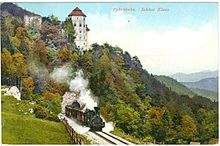Klaus Castle
Klaus Castle is a castle complex in Upper Austria , the beginnings of which go back to the 12th century, which today houses a Protestant youth leisure center and educational center. The facility is located on a ledge in the Steyrtal , at the foot of the Brennet mountain , the southernmost foothills of the Kremsmauer .
history
At first it was a fortress on the road through the valley near Klaus an der Pyhrnbahn . The first documentary evidence can be found in 1175. In 1282 Albrecht von Habsburg enfeoffed Albero de Buchheim as thanks for loyal military service with the "strong Klaus festival". After the rule of Klaus was pledged to the Spital Abbey in 1477, the fort came into the possession of the Storch family in 1512.
In 1578 Ulrich von Storch built a castle directly below the existing fortress , which was converted to Baroque style in 1758 . In 1610 the subjects of Klaus, under the leadership of Ludwig and Christoph Storch, prevented around 8000 soldiers of the “Passau war people” from passing through the valley. 1616–1618 Ludwig von Storch built a Protestant mountain church with a cemetery and a preacher's apartment above the castle . This complex was taken over by the Catholic parish church of Klaus as a late consequence of the Counter-Reformation in 1674.
In 1632 the Storch family had to leave Austria for reasons of faith and moved to Vach near Fürth (Franconia), where the sacrament implements donated for the Klauser Bergkirche are still in use today. The rule of Klaus was sold to the baron (from 1665 "Count") Georg Siegmund von Salburg . In 1708 the facility passed into the possession of Count Franz Ludwig von Salburg. In 1742 Baron von Trenck , who was in the service of Archduchess Maria Theresa, drew attention to Klaus. Bavarian and French soldiers invaded Upper Austria and also conquered the Klaus fortress. In the early morning hours of January 2, she caught Trenck by surprise after a feast, conquered the castle and after a short battle, captured 130 men. Count Norbert Anton Oswald Salburg sold the property to Spital am Pyhrn Abbey in 1760 .
In 1809 the castle and castle became the property of the Obderennsischer Religionsfonds , in 1828 the roof of the castle was demolished in order not to have to pay a roof tax for the old wing, which was already uninhabited at the time. In 1889 the rule of Klaus was removed from the kk religious fund and sold to the prince of Schaumburg-Lippe . The entire property with 574 hectares of forest was sold on December 13, 1940 to the Berlin squire Sigismund von Treskow , who bequeathed it to his niece Ursula von Sydow in 1945 . Since the last owners could not live in the old castle either, the basic requirements for the preservation of the historical building were no longer given. Immediately after the Second World War , the castle was used as refugee accommodation. From 1948 it served as a rest home for children from the diocese of Vienna cared for by Caritas for two years . The structural condition deteriorated rapidly and the last remnants of the castle ruins threatened to collapse. For this reason the property became de facto unusable.
In 1963, a lease contract was signed between Baroness Ursula von Sydow and her son Wilhelm von Sydow and the evangelical-church association Missionsgemeinschaft der Torchträger under the direction of Peter Wiegand . The first renovation work began on the castle, where a few months later a Protestant youth leisure center and educational center opened.
Due to the large number of guests, it was decided in 1983 to rebuild the castle ruins. The palace and castle now offer two large meeting rooms and 150 guest beds and record around 20,000 overnight stays per year. In addition to operating as a Christian youth leisure center and educational center, Schloss Klaus today runs a diaconal facility for people with disabilities in the region under the name Diakonie in der Gemeinde (DIG) , and also administers several mission and development aid projects.
- Historical views
Castle and castle ruins on a colored picture postcard from 1909. In the foreground a Pyhrnbahn train
literature
- Irmgard Bachl: Klaus, Steyrling, Kniewas. My home, our home . Leonding, Klaus 1996-1997.
- Marianne Oberladstätter: Castle and Castle Klaus. An exciting journey through history . Klaus 2011.
Individual evidence
- ↑ Legends and monuments at the heart of local history lessons. In: home chronicle of the elementary school Klaus. 1936.
- ^ Irmgard Bachl: Klaus, Steyrling, Kniewas. My home, our home. Steyrling, 1996, p. 21.
- ^ P. Eberhard Bauer: Historical notes from Klaus. Wels, 1889, p. 26.
- ↑ Gertrud Dirngrabner: The rule Klaus (Upper Austria) from 1512 to 1761. Inaugural dissertation to obtain the doctorate of the philosophical faculty at the Karl-Franzens-University in Graz. 1958, pp. 122-123.
- ^ Markus Pöllinger: 950 years of St. Matthew in Vach. 2009, pp. 75-81.
- ↑ Rudolf Stranzel: Castle Klaus - the only noble residence in Pyhrn-Priel. In: Windischgarstner Kurier. Jan 1989, p. 12.
- ^ Wilhelm Sydow: Castle Klaus in the 20th century. In: Franz Josef Limberger (Ed.): KLAUS - Harmony of Opposites. Kirchdorf 1992, pp. 97-99.
- ↑ Joan Thomas: Major W. Ian Thomas and the History of the Torchbearers. Holzgerlingen 2015, p. 147.
- ^ Lutz Kettwig: New life in old walls. In: Franz Josef Limberger (Ed.): KLAUS - Harmony of Opposites. Kirchdorf 1992, pp. 100-102.
- ^ Peter Wiegand: Brief historical summary of Schloss Klaus. In: Franz R. Vorderwinkler (Ed.): On the trail of culture - museums, monasteries, castles, palaces in Upper Austria. Steyr, 1997, pp. 90-93.
Web links
- Site of the castle
- Schloss Klaus on Facebook
- Entry about Klaus am Pyhrn on Burgen-Austria
Coordinates: 47 ° 49 ′ 25 ″ N , 14 ° 9 ′ 17 ″ E





